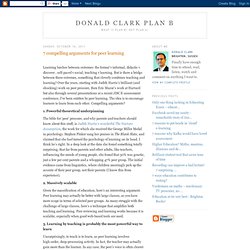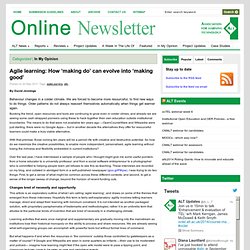

Digital Literacy in Higher Education. UCISA Mobile learning: How mobile technologies can enhance the learning experience. Mobile learning Jisc Infokit. John Dewey, writing in the early years of the twentieth century, may not have foreseen the proliferation of 21st century ‘mobile devices’ but, in the quotation to the right, he does point out something that remains relevant: that mobile learning involves change, initiative and adaptability.

Mobile learning involves change in the sense that the ability to communicate with tutors and peers, as well as access learning resources, changes what is possible in education. It takes initiative for leaders to create a vision to sustain that change and, finally, mobile learning requires adaptability by members of staff to carry out the change. This infoKit is a practical guide to thinking through the issues relating to institutional adoption of mobile learning. It follows a JISC Mobile and Wireless Technologies Review which delves deeper into the theory behind mobile learning and the wider context. Emerging Practice in a Digital Age Bee motif. Learning design for online courses: a webinar with Diana Laurillard. 7 compelling arguments for peer learning. Learning lurches between extremes: the formal v informal, didactic v discover , self-paced v social, teaching v learning.

But is there a bridge between these extremes, something that cleverly combines teaching and learning? Over the years, starting with Judith Harris’s brilliant (and shocking) work on peer pressure, then Eric Mazur’s work at Harvard but also through several presentations at a recent JISC E-assessment conference, I’ve been smitten by peer learning. The idea is to encourage learners to learn from each other. Compelling arguments? 1. The bible for ‘peer’ pressure, and why parents and teachers should know about this stuff, is Judith Harris’s wonderful The Nurture Assumption, the work for which she received the George Miller Medal in psychology. 2.
Given the massification of education, here’s an interesting argument. 3. Unsurprisingly, to teach is to learn, as peer learning involves high-order, deep-processing activity. 4. 5. 6. 7. The Saylor Foundation: Connecting the Dots. Online Education, Udacity, MOOC, Open Ed. Agile learning: How ‘making do’ can evolve into ‘making good’ By David Jennings Behaviour changes in a colder climate.

We are forced to become more resourceful, to find new ways to do things. Older patterns do not always reassert themselves automatically when things get warmer again. Bucking the trend, open resources and tools are continuing to grow even in colder climes, and already we are seeing some cash-strapped pioneers using these to hack together their own education outside institutional boundaries. The means to do that were not available ten years ago —OpenCourseWare and Wikipedia were just starting, there were no Google Apps— but in another decade the alternatives they offer for resourceful learners could make a truly viable alternative.
With that premise, those coming ten years will be a period rife with creative and destructive potential. Changes bred of necessity and opportunity This article is an exploratory outline of what I am calling ‘agile learning’, and draws on some of the themes that emerged from these interviews. References. The Edupunks' Guide To a DIY Credential. Media.wiley.com/product_data/excerpt/06/04704613/0470461306.pdf. The Self Organised Learning Environment (SOLE) School Support Pack. Learning design for online courses: a webinar with Diana Laurillard.